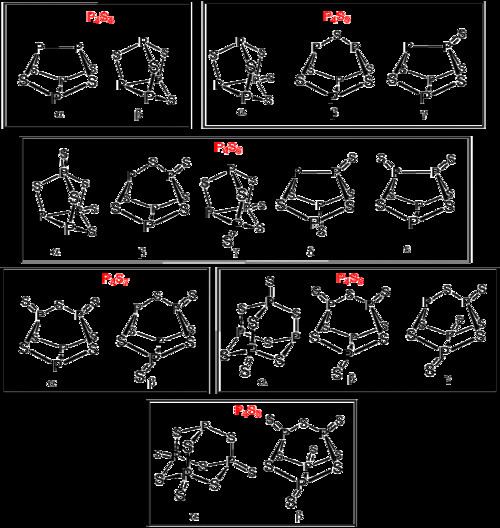 | ||
Phosphorus sulfides comprise a family of inorganic compounds containing only phosphorus and sulfur. These compounds have the formula P4Sx with x ≤ 10. Two are of commercial significance, phosphorus pentasulfide (P4S10), which is made on a kiloton scale for the production of other organosulfur compounds, and phosphorus sesquisulfide (P4S3), used in the production of "strike anywhere matches".
Contents
There are several other phosphorus sulfides in addition to P4S3 and P4S10. Six of these phosphorus sulfides exist as isomers: P4S4, P4S5, P4S6, P4S7, P4S8, and P4S9. These isomers are distinguished by Greek letter prefixes. The prefix is based on the order of the discovery of the isomers, not their structure. All known molecular phosphorus sulfides contain a tetrahedral array of four phosphorus atoms. P4S2 is also known but is unstable above −30 °C.
Preparation
The main method for preparing these compounds is thermolysis of mixtures of phosphorus and sulfur. The product distributions can be analyzed by 31P NMR spectroscopy. More selective syntheses entail (i) desulfurization, e.g. using triphenylphosphine and, complementarily, (ii) sulfidation using triphenylarsine sulfide.
P4S3
Phosphorus sesquisulfide is prepared by treating red phosphorus with sulfur above 450 K, followed by careful recrystallization with carbon disulfide and benzene. An alternative method involves the controlled fusion of white phosphorus with sulfur in an inert, non-flammable solvent.
P4S4
The α- and β- forms of P4S4 can be prepared by treating the corresponding isomers of P4S3I2 with ((CH3)3Sn)2S:
P4S3I2 can be synthesized by the reaction of stoichiometric amounts of phosphorus, sulfur, and iodine.
P4S5
P4S5 can be prepared by treating stoichiometric amounts of P4S3 with sulfur in carbon disulfide solution, in the presence of light and a catalytic amount of iodine. The respective product distribution is then analyzed by using 31P NMR spectroscopy.
In particular, α-P4S5 can be easily made by the photochemical reaction of P4S10 with red phosphorus. Note that P4S5 is unstable when heated, tending to disproportionate to P4S3 and P4S7 before reaching its melting point.
P4S6
P4S6 can be made by abstracting a sulfur atom from P4S7 using triphenylphosphine:
P4S7 + Ph3P → P4S6 + Ph3PSThe two new polymorphs δ-P4S6 and ε-P4S6 can be made by treating α-P4S4 with Ph3SbS in CS2.
P4S7
P4S7 is most conveniently made by direct union of the corresponding elements, and is one of the most easily purified binary phosphorus sulfides.
4 P + 7 S → P4S7P4S9
P4S9 can be made by two methods. One method involves the heating of P4S3 in excess sulfur. nothing method involves the heating of P4S7 and P4S10 in 1:2 mole ratio, where P4S9 is reversibly formed:
P4S7 + 2 P4S10 ⇌ 3 P4S9P4S10
P4S10 is one of the most stable phosphorus sulfides. It is most easily made by heating white phosphorus with sulfur above 570 K in an evacuated tube.
P4 + 10 S → P4S10